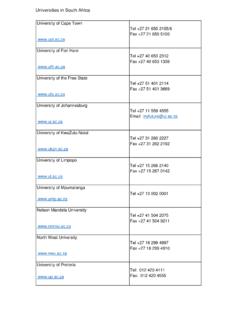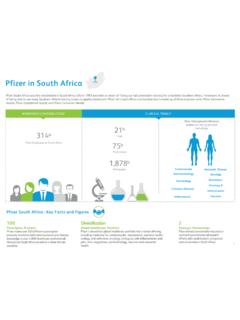Transcription of MINIMUM DATA SETS FOR HUMAN RESOURCES FOR HEALTH …
1 CASE STUDY | south africa . MINIMUM DATA SETS FOR HUMAN . RESOURCES FOR HEALTH AND THE. SURGICAL WORKFORCE IN. south africa 'S. HEALTH SYSTEM. A rapid analysis of stock and migration Acknowledgements The authors of this report are Percy Mahlathi and Jabu Dlamini (African Institute of HEALTH & Leadership Development). Comments on an earlier draft were provided by James Buchan (University of Technology, Sidney) and Giorgio Cometto (WHO). This document is an unedited draft, not to be referenced, published or disseminated without prior permission of the African Institute for HEALTH and Leadership Development and WHO. Funding for the development of this document was provided through the project Brain Drain to Brain Gain - Supporting WHO.
2 Code of practice on International Recruitment of HEALTH personnel for Better Management of HEALTH Worker Migration , co-funded by the European Union (DCI-MIGR/2013/282-931) and Norad, and coordinated by WHO. The contents of this document are the sole responsibility of the African Institute for HEALTH and Leadership Development, and can under no circumstances be regarded as reflecting the position of the European Union or WHO. African Institute for HEALTH and Leadership Development, all rights reserved. September 2015. Contents 2. 1. Constitutional and organizational context of south African HEALTH 3. HEALTH workforce 4. Migration of the HEALTH 5. 2. Objectives and Study 6. 6. 3.
3 MINIMUM data 6. Stock inflows (production).. 8. Stock in 8. Surgical 9. 4. 10. 5. 12. WHAT THE STATE OF KERALA TELLS US ABOUT THE PRODUCTION, STOCK AAND. RAPID ANALYSISOFOFTHE. MIGRATION STOCK ANDWORKFORCE. HEALTH MIGRATION 1. Abstract Background. The provision of HEALTH services is largely dependent on the sufficiency of the HEALTH workforce in terms of numbers, the quality of skills they possess, how and where they are deployed and how they are managed. With increasing urbanization, the issue of migration (in all forms) of HEALTH personnel has become a critical factor in the debate about social justice in HEALTH , especially access and equity in the provision of HEALTH services.
4 This case study seeks to establish the existence of a system that is necessary if HEALTH authorities are to improve the management of HEALTH workforce migration. Objectives. The objectives of the study were to determine the MINIMUM data sets that are recorded by government, statutory HEALTH councils and professional associations in their management systems; determine the stock of HEALTH professionals involved in surgical care; and establish the existence of data and systems to manage the emigration of south African HEALTH professionals. Method. Data were collected from the National Ministry of HEALTH , provincial departments of HEALTH , statutory HEALTH councils ( HEALTH Professions Council of south africa , south African Nursing Council and south African Pharmacy Council) and the south African Society of Anaesthesiologists.
5 The data sources that were utilized fell into the following categories: policies ( HEALTH policies that relate to the HEALTH workforce); status report from a payroll system (specific focus on the workforce); and statutory HEALTH council annual reports and responses to a survey questionnaire. Results. Data analysis revealed that the provincial departments of HEALTH do not collect information on employees in a uniform manner. There is no distinct national register of categories making up the surgical workforce. However, the scopes of practice that are developed by the statutory HEALTH councils dictate who can offer surgical care. Consequently the surgical workforce is mostly made up of medical specialties and medical officers.
6 There is however no quantifiable information relating to numbers of medical officers offering surgical care at HEALTH facilities. Conclusion. The country needs to improve collaboration between stakeholders that have HUMAN RESOURCES for HEALTH data management systems; modify and strengthen the use of the current public service-wide HUMAN RESOURCES system (Vulindlela) to cater for HEALTH -specific HUMAN RESOURCES data; and strengthen its workforce planning capability by ensuring the existence of an appropriate national HEALTH workforce information system. This should straddle both public and private HEALTH sectors, including the statutory HEALTH councils. The National Ministry of HEALTH and Ministry of Home Affairs need to improve their collaboration on the measurement and monitoring of emigration by south African HEALTH professionals.
7 Key words: emigration, immigration, MINIMUM data sets, HEALTH professionals, south africa 2 MINIMUM DATA SETS FOR HUMAN RESOURCES FOR HEALTH AND THE SURGICAL WORKFORCE IN south africa 'S HEALTH SYSTEM. MINIMUM DATA SETS FOR HUMAN RESOURCES . FOR HEALTH AND THE SURGICAL WORKFORCE IN. south africa 'S HEALTH SYSTEM. A rapid analysis of stock and migration 1. Background sector serves 16% of the population while the public sec- tor serves 84% (3). The country's population distribution Constitutional and organizational indicates that about inhabit the provinces that are context of south African HEALTH system largely rural in nature. Some of these provinces contain south africa has an estimated population of 54 956 900 large cities, though the bulk of the population lives in (1), the majority of whom access HEALTH services through rural communities.
8 Table 1 shows population estimates government-run public clinics and hospitals. The HEALTH and distribution by province. system comprises the public sector (run by the govern- ment) and the private sector. The public HEALTH services There is realization that the HEALTH workforce plays a are divided into primary, secondary and tertiary through critical role in advancing the HEALTH system goals, largely HEALTH facilities that are located in and managed by the driven by a policy position of improving access to HEALTH provincial departments of HEALTH . The provincial depart- ments are thus the direct employers of the HEALTH work- force while the National Ministry of HEALTH is responsible TABLE 1.
9 south africa : POPULATION TOTALS AND. for policy development and coordination. DISTRIBUTION BY PROVINCE (MIDYEAR 2015). Population % of total south africa 's Constitution guarantees every citizen ac- Province estimate population cess to HEALTH services (section 27 of the Bill of Rights). Eastern Cape 6 916 200 However, everyone can access both public and private Free State 2 817 900 HEALTH services, with access to private HEALTH services depending on an individual's ability to pay. The private Gauteng 13 200 300 HEALTH sector provides HEALTH services through individ- KwaZulu-Natal 10 919 100 ual practitioners who run private surgeries or through Limpopo 5 726 800 private hospitals, which tend to be located in urban Mpumalanga 4 282 900 areas.
10 The HEALTH care system consumed about of Northern Cape 1 185 600 the country's gross domestic product during 2012 (2). North West 3 707 000 The majority of patients access HEALTH services through the public sector District HEALTH System, which is the Western Cape 6 200 100 preferred government mechanism for HEALTH provision Total 54 956 900 within a primary HEALTH care approach. The private Source: Statistics south africa (1). A RAPID ANALYSIS OF STOCK AND MIGRATION 3. FIGURE 1. ORGANIZATION OF THE south AFRICAN HEALTH SYSTEM. 1a. Macro-organization of the south African 1b. Organization of the south African public HEALTH HEALTH system sector North West Department Northern of HEALTH Cape EC.














